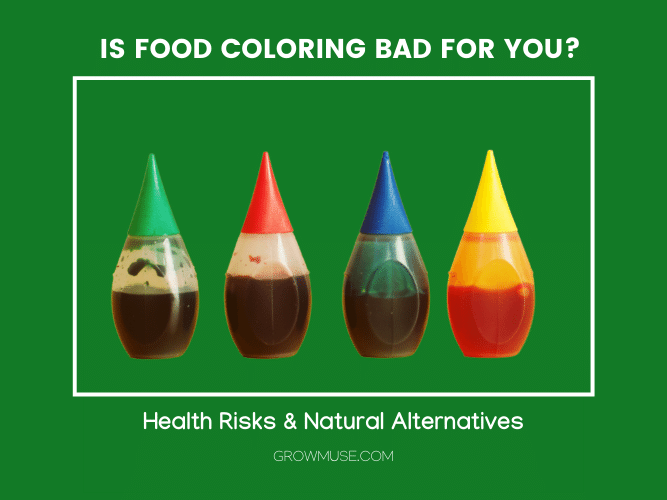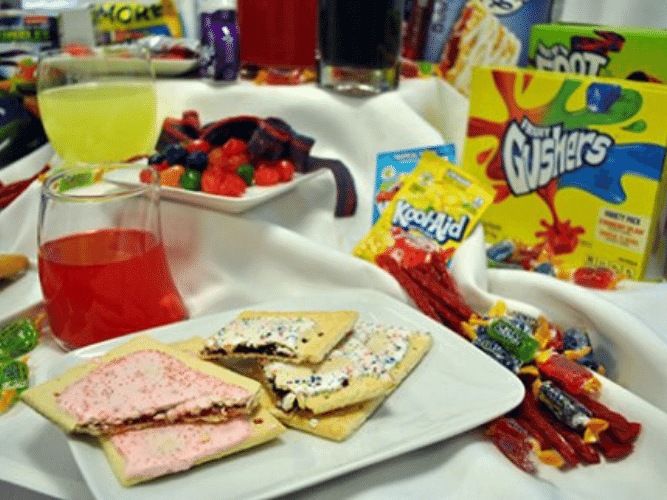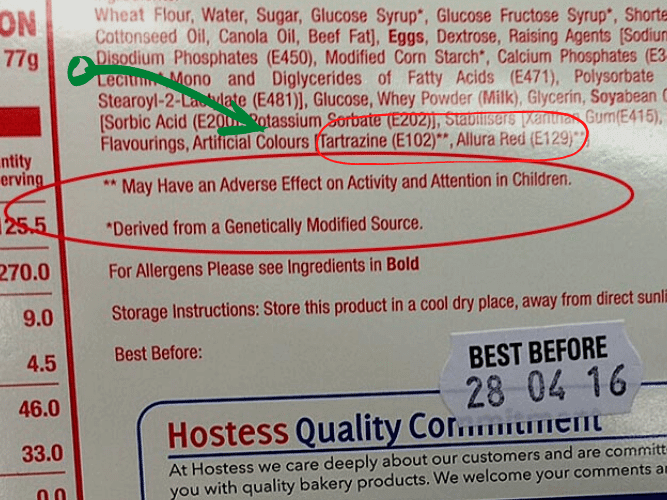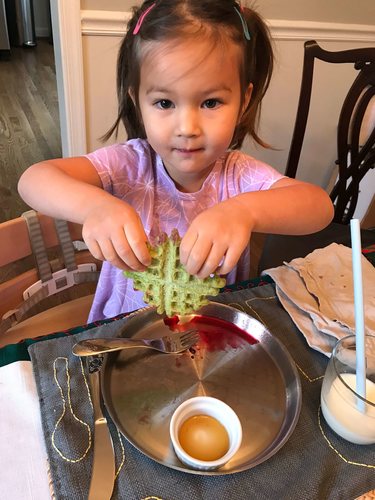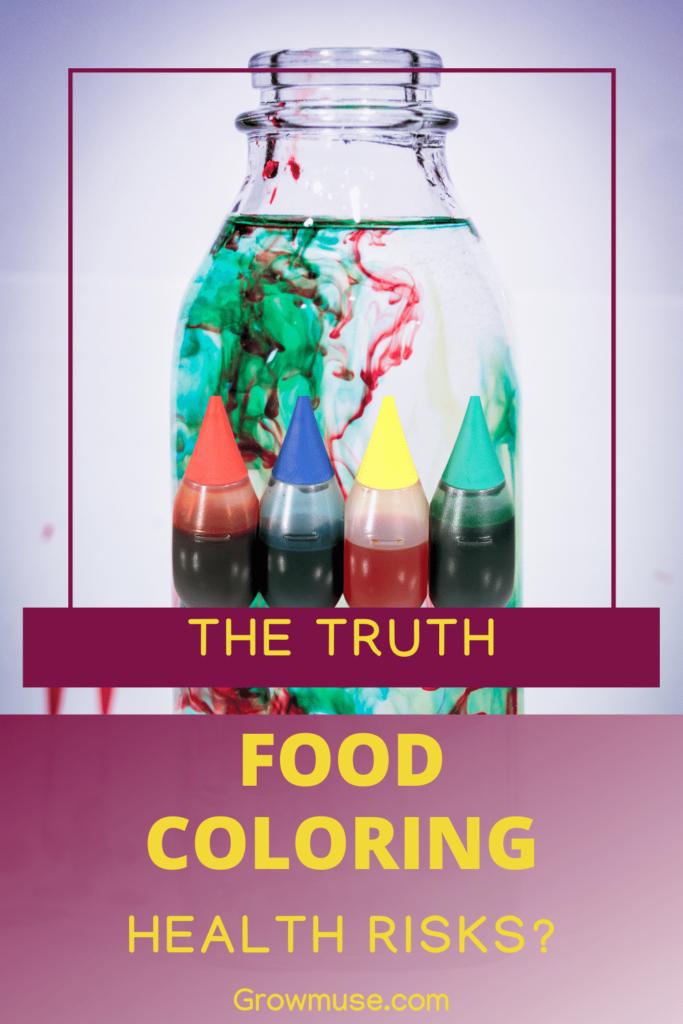
Any links on this page that lead to products on Amazon are affiliate links and I earn a commission if you make a purchase. Thanks in advance for your support! Read the full disclosure here.
Is food coloring bad for you?
I dove into this topic after my toddler ate what I thought was a harmless ring pop. Her behavior after eating half of it was erratic. She woke up later that evening screaming of nightmares.
This was highly unusual for her to act this way. Everything else about the day was consistent with her normal routine. The only change would have been with her diet and that ring pop! After looking into the ingredients on the package, I noticed Red 40, Yellow 5, Blue 1.
In the United States food manufacturers add food coloring to pretty much everything. There’s Red 3 dye in bottled cherries, Red 40 in a McDonald’s strawberry sundae, and Yellow 6 in Starburst fruit chews.
Table of Contents
The Truth Behind Food Coloring In the United States
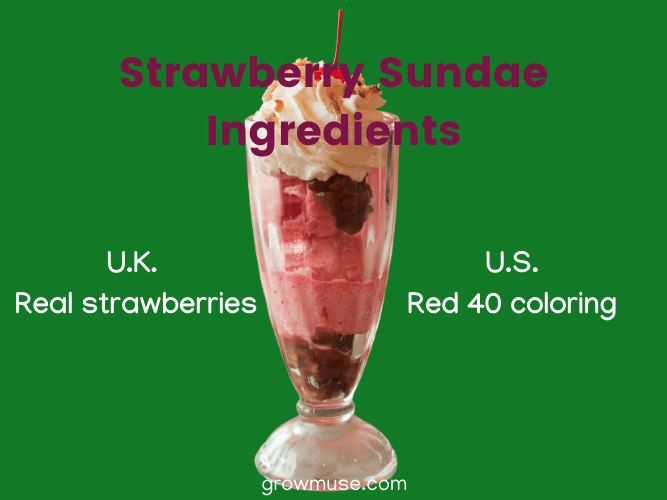
I found it really intriguing that in Britain, the McDonalds strawberry ice cream gets its color from real strawberries. Here in the U.S. they use artificial dyes.
The only purpose of food coloring is to make the things you eat a little prettier. There’s no other added benefits to your health. In fact, studies have shown quite a bit of negative effects.
Food coloring has been associated with negative effects on the body like hyperactivity, depression, irritability, and skin rashes, to name a few.
This all makes sense considering most synthetic food dyes are derived from petroleum, or crude oil. Gross.
I’ll share the truth behind where you can find color additives, how these artificial colors affect your health, and natural alternative color swaps to consider.
Where Are Artificial Colors Used?
You can find artificial colors in just about any food you eat.
- Carbonated Drinks
- Meat
- Cereal
- Oil
- Butter
- Chewing Gum
- Beer
- Baked Goods
- Sauces
- Fish
- Soda
- Juice
- Dried Fruit
Why Are Artificial Colors Used?
Artificial colors help with marketing and sales. You associate cherries and oranges to be bright red and orange, so companies add coloring to help you buy these products.
There was a study where people tasted drinks with different shades of red. They said the drinks with deeper color red tasted sweeter than the lighter red drinks.
Another study showed people having a difficult time identifying drink flavors when the color didn’t match the taste. For example, people thought an orange colored drink that was cherry-flavored, actually tasted like an orange.
“These synthetic chemicals do absolutely nothing to improve the nutritional quality or safety of foods, but trigger behavior problems in children and, possibly, cancer in anybody. The Food and Drug Administration should ban dyes, which would force industry to color foods with real food ingredients, not toxic petrochemicals.”
Center for Science in the Public Interest
U.S. FDA Approved Food Coloring

Source: Special-Education-Degree.net
Unlike the U.K. The United States still allows for synthetic food coloring.
The Center for Science in the Public Interest has tried to make a case with the FDA to ban these dyes based on links to behavioral problems.
Isn’t it odd that Fanta orange soda in the United Kingdom gets its color from pumpkin and carrot extracts, while the same soda in the United States uses Red 40 and Yellow 6?
The UK uses real strawberries for coloring its McDonalds sundaes, but the US uses Red 40.
Artificial dyes are much cheaper than natural dyes from plants, animals, and minerals. Companies have taken advantage of lower prices, made the switch to artificial colors, and have trained the consumer to buy products with these more vibrant colors.
The U.K. Requires Warning Labels For Products Containing Artificial Coloring
In the U.K. if a company wanted to add artificial dyes, they’d have to add the verbiage below about the food.
The food “may have an adverse effect on activity and attention in children.”
Rather than add this harsh warning label, many manufacturers choose to do away with artificial dyes. Take M&Ms for example. They aren’t as brightly colored compared to ones you’ll find in the U.S.
A Nutri-Grain strawberry cereal bar in the U.S. has Red 40, Yellow 6, and Blue 1.
In the U.K. the Nutri-Grain strawberry bar contains beetroot red, annatto and paprika extract.
What Happens When You Eat Foods Containing Food Coloring?
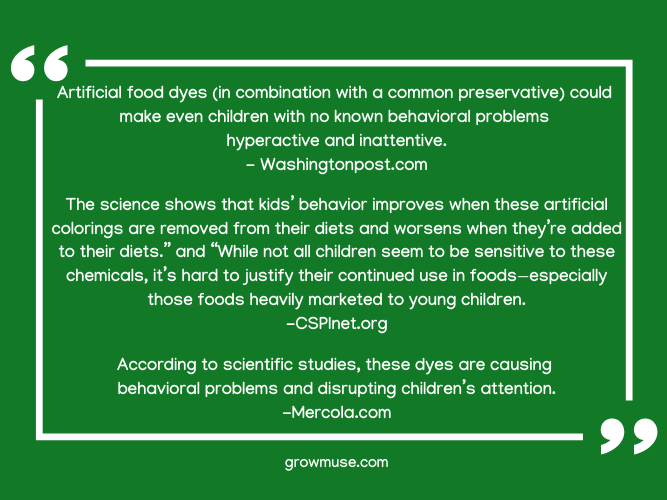
Countries are well aware of the risks caused from artificial dyes that have been tested to negatively affect your health.
As you can see with the U.S. they’re still allowing these food additives. Since 1955 the consumption of food dyes per person has increased by five times.
Red 40, Yellow 5, and Yellow 6 contribute to 90% of the total food dyes in food. These dyes contain benzidine, a human and animal carcinogen. Carcinogens may cause cancer.
One study showed after the elimination of artificial food dyes, 73% of kids with ADHD had a decrease in symptoms.
Another study looked at Yellow 5 and showed behavioral changes of irritability, depression, and difficulty sleeping.
An analysis of 15 studies came to the conclusion that artificial food dyes do in fact lead to hyperactivity in kids.
Possible Side Effects From Food Coloring
| FOOD COLORING | WHERE IS IT USED? | POSSIBLE EFFECTS |
| Blue 1 | Beverages, candy, baked goods | Associated with hyperactivity and skin rashes, DNA damage and tumours in animals and increased cancer risk in humans. |
| Blue 2 | Pet food, beverages, candy | May cause nausea, vomiting, skin rashes, breathing problems and brain tumours. Associated with hyperactivity and skin rashes. Associated with DNA damage and tumours in animals and increased cancer risk in humans. |
| Citrus Red 2 | Skin of some Florida oranges only | Associated with increase in asthmatic symptoms, rashes and hyperactivity. Potential carcinogen in animals: implicated in bladder and liver cancer. Potential endocrine disruptor. |
| Green 3 | Candy, beverages | Associated with hyperactivity, asthma, skin rashes, and migraine headaches. |
| Orange B | Sausages | Associated with increased risk of cancer due to carcinogenic contaminants. |
| Red 3 | Candy, baked goods | Associated with increased risk of cancer |
| Red 40 | Soda pop, candy, gelatin desserts, pastries, pet food, sausage | May worsen or induce asthma, rhinitis (including hayfever), or urticaria (hives). |
| Yellow 5 | Gelatin dessert, candy, pet food, baked goods | Associated with hyperactivity, asthma, skin rashes, and migraine headaches. |
| Yellow 6 | Beverages, candy, baked goods | Associated with growth retardation and severe weight loss in animal studies. Can contribute to life threatening respiratory issues in those that suffer from asthma or allergies. Associated with DNA damage and tumours in animals and increased cancer risk in humans. |
What Is Food Coloring Made Of?
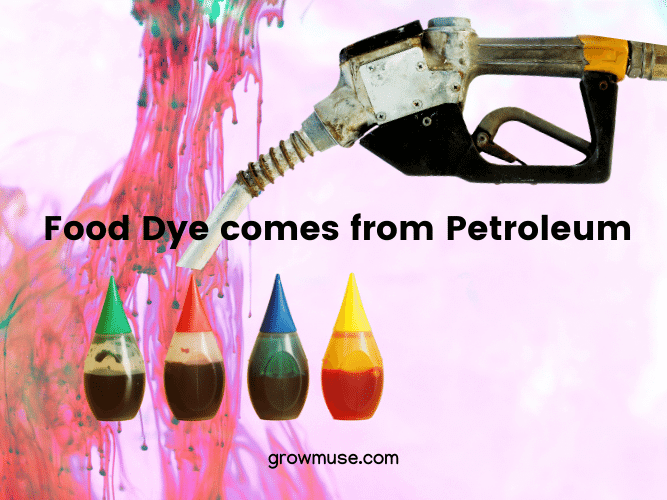
Why would food coloring make people sick? Let’s look at what makes up some of the food dyes used in food.
Blue 1: Derived from coal tar. Now produced from an oil base.
Blue 2: Synthetic version of plant-based indigo used to color blue jeans.
Yellow 5: Made from petroleum products
Green 3: Combination of blue and yellow additives.
Most food coloring is made up of synthetic petroleum-based chemicals called dyes. These dyes do not occur in nature. It’s pretty easy to pinpoint where these dyes are used because they’re mostly in food with little nutritional value like candy, soda, etc.
What Are Food Coloring Alternatives?
Hopefully this article didn’t bum you out too much. I wanted to present you with the facts so you can make your own decision around eating foods with synthetic dyes.
We should all still enjoy eating rainbow colored cookies, green cupcakes, and pink candy on Valentine’s Day.
So what are the alternatives to artificial colors then?
Use coloring from these natural foods. They won’t be as bright or vibrant as their synthetic counterparts, but they also won’t make you hyperactive or break out in rashes.
- Beets
- Carrots
- Spinach
- Pumpkin
- Berries
- Red cabbage
- Turmeric powder
- Saffron powder
- Paprika
Natural Food Coloring DIY

Here are some ingredients you can use to make your favorite dyes.
Note: When using natural ingredients, you will notice a bit of flavor from that source in your food. For example, if you make green waffles using spinach powder, it will have a faint hint of spinach.
Start with ½ – 1 teaspoon in any recipe first to taste. A little may go a long way.
| Color | Natural Source |
| Orange | Pumpkin, Carrot Juice, sweet potatoes, paprika |
| Yellow | Turmeric powder, saffron flowers, butternut squash |
| Green | Spinach or Kale Juice, matcha powder |
| Blue | Blueberries |
| Purple | Purple Potatoes, Blackberries |
| Brown | Coffee, tea, cocoa powder |
| Pink | Raspberries, strawberries |
| Red | Raspberries, Beet root, pomegranate juice, cranberry juice, tomatoes, cherries |
Products Made With Natural Food Coloring Ingredients
Here are some really great alternatives to artificial colorings if you don’t want to make your own powders or mixes.
| Product | Title | Buy |
|---|---|---|
 | India Tree Nature's Colors Decorating Set | Check Amazon Price |
 | Red Beet Supercolor Powder | Check Amazon Price |
 | Pink Pitaya Supercolor Powder | Check Amazon Price |
 | Blue Butterfly Pea Supercolor Powder | Check Amazon Price |
 | Purple Sweet Potato Supercolor Powder | Check Amazon Price |
 | Green Pandan Leaf Supercolor Powder | Check Amazon Price |
 | Yellow Goldenberry Powder | Check Amazon Price |
 | Orange Carrot Supercolor Powder | Check Amazon Price |
Final Thoughts: Food Coloring Is Bad – Use Natural Food Coloring

Green Waffles (used homemade kale powder) 
Daughter Loves These!
Who knew that so many of the foods we treat ourselves with can hurt us and our families?
These dangerous synthetic food dyes are mostly found in candy and junk food. When you have a hunch, just flip the package over and scan the ingredients for these food dyes.
If you see in the ingredients list: Blue 1, Blue 2, Citrus Red 2, Green 3, Orange B, Red 3, Red 40, Yellow 5, or Yellow 6, DROP IT!
That 5 seconds of enjoyment eating whatever it is with those synthetic dyes is not worth the potential risks.
Risks include hyperactivity, headaches, increased risk of cancer, and skin rashes.
When you’re making your own food at home, opt for all natural food coloring. Whether you go the total DIY route and make your own colors, or buy some online, look at the labels.
Have you tried any alternative, natural food colorings at home? Comment below and tell me how it went!
Growmuse.com is a participant in the Amazon Services LLC Associates Program, an affiliate advertising program designed to provide a means for sites to earn commission by linking to Amazon.com. This is done at no cost to you. Read the full disclosure here.
Where Are Artificial Colors Used?
Carbonated Drinks, Meat, Cereal, Oil, Butter, Chewing Gum, Beer, Baked Goods, Sauces, Fish, Soda, Juice, Dried Fruit, any many more.
Why Are Artificial Colors Used?
Purely for marketing and sales because they add no nutritional value.
What Happens When You Eat Foods Containing Food Coloring?
Lead to cancer, hyperactivity in kids, trouble sleeping, behavioral problems, irritability, skin rashes, to name a few.

